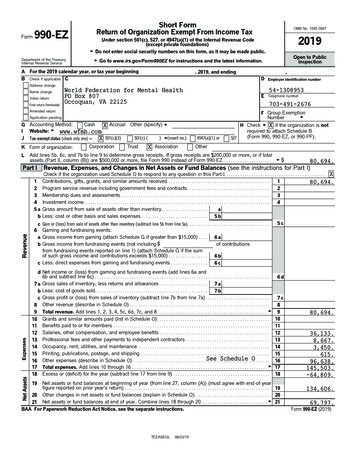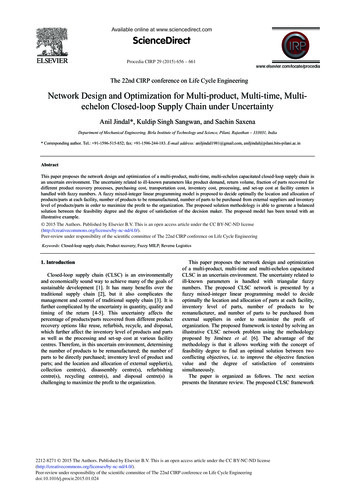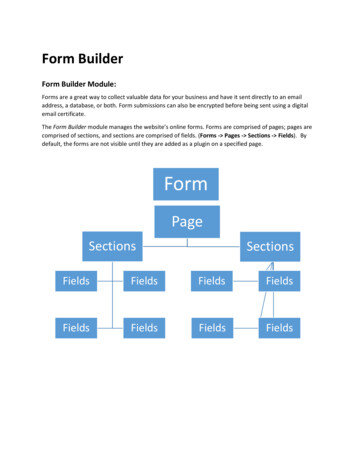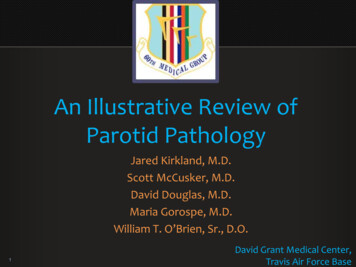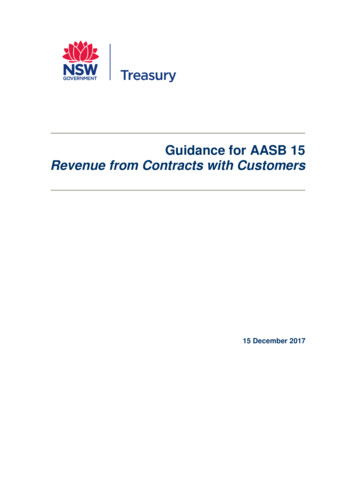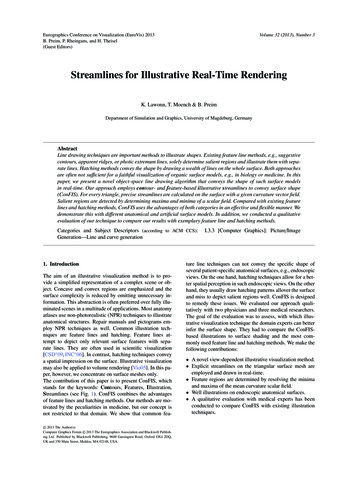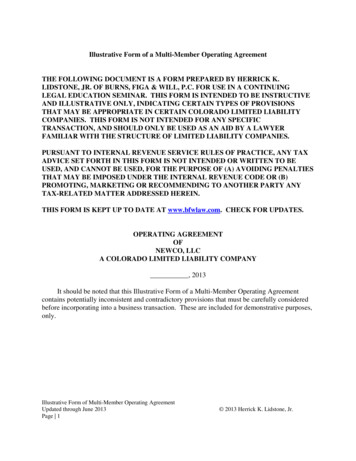
Transcription
Illustrative Form of a Multi-Member Operating AgreementTHE FOLLOWING DOCUMENT IS A FORM PREPARED BY HERRICK K.LIDSTONE, JR. OF BURNS, FIGA & WILL, P.C. FOR USE IN A CONTINUINGLEGAL EDUCATION SEMINAR. THIS FORM IS INTENDED TO BE INSTRUCTIVEAND ILLUSTRATIVE ONLY, INDICATING CERTAIN TYPES OF PROVISIONSTHAT MAY BE APPROPRIATE IN CERTAIN COLORADO LIMITED LIABILITYCOMPANIES. THIS FORM IS NOT INTENDED FOR ANY SPECIFICTRANSACTION, AND SHOULD ONLY BE USED AS AN AID BY A LAWYERFAMILIAR WITH THE STRUCTURE OF LIMITED LIABILITY COMPANIES.PURSUANT TO INTERNAL REVENUE SERVICE RULES OF PRACTICE, ANY TAXADVICE SET FORTH IN THIS FORM IS NOT INTENDED OR WRITTEN TO BEUSED, AND CANNOT BE USED, FOR THE PURPOSE OF (A) AVOIDING PENALTIESTHAT MAY BE IMPOSED UNDER THE INTERNAL REVENUE CODE OR (B)PROMOTING, MARKETING OR RECOMMENDING TO ANOTHER PARTY ANYTAX-RELATED MATTER ADDRESSED HEREIN.THIS FORM IS KEPT UP TO DATE AT www.bfwlaw.com. CHECK FOR UPDATES.OPERATING AGREEMENTOFNEWCO, LLCA COLORADO LIMITED LIABILITY COMPANY, 2013It should be noted that this Illustrative Form of a Multi-Member Operating Agreementcontains potentially inconsistent and contradictory provisions that must be carefully consideredbefore incorporating into a business transaction. These are included for demonstrative purposes,only.Illustrative Form of Multi-Member Operating AgreementUpdated through June 2013Page 1 2013 Herrick K. Lidstone, Jr.
OPERATING AGREEMENT1This Agreement is effective as of the day of 2013, by the Managers and theMembers of NEWCO, LLC, a Colorado limited liability company whose signatures appear onthe signature page hereto, and supercedes all other understandings with respect thereto.ARTICLE 1)DEFINITIONSThe following terms used in this Operating Agreement shall have the following meanings(unless otherwise expressly provided herein);1.1“Affiliate” shall mean any Person controlling, controlled by or under commoncontrol with a Person, including a Person controlled separately by a Member or collectively bythe Members.1.2“Articles of Organization” shall mean the Articles of Organization of NEWCO,LLC as filed with the Secretary of State of Colorado as the same may be amended from time-totime.1.3“Assignee” shall mean the owner of an Economic Interest who is not a Member.1.4“Bank” means a commercial bank or savings and loan association or otherfinancial institution that is in the business of making loans to commercial enterprises that is notaffiliated with a Member. When used in the preceding sentence, the term “not affiliated with”means that no Member or family member living in the home of such Member is an officer ordirector of the Bank, or (directly or indirectly) owns more than 1% of the outstanding equityinterest in such Bank.1It is important to note that, in drafting an operating agreement under the Colorado Limited LiabilityCompany Act (C.R.S. § 7-80-101 et seq.), the Colorado legislators expressed their intention “to give the maximumeffect to the principle of freedom of contract and to the enforceability of operating agreements.” C.R.S. § 7-80108(4). Thus it is important for the draftsperson to consider all relevant issues with the client, and then “scriven withprecision.” See Willie Gary LLC v. James & Jackson, LLC, 2006 WL 75309, at *2 (Del.Ch.Ct. Jan. 10, 2006),affirmed sub nom. James & Jackson, LLC v. Willie Gary LLC, No. 59-2006 (Del. Sup. Ct. Mar. 21, 2006). Therethe issue was a dispute resolution clause which the court found was “unwieldy” but sufficiently clear to deny amotion to dismiss for arbitration of the claims. See, also, Kleinberger, “Careful What You Wish For – Freedom ofContract and the Necessity of Careful Scrivening” XXIV Pubogram 19 (October 2006), available athttp://ssrn.com/abstract 939009. The examples of operating agreements being interpreted in courts and foundwanting are too numerous to number.Illustrative Form of Multi-Member Operating AgreementUpdated through June 2013Page 2 2013 Herrick K. Lidstone, Jr.
1.5“Business” shall mean the business of the Company as it may be set forth fromtime-to-time in any business plan, budget, operating plan, by resolution of the Managers, or bythe Company’s operations. [further description?]21.6“Capital Account” means, with respect to any Member or Assignee, the CapitalAccount maintained for such Person in accordance with the requirements of the Code including(without limitation) § 704(b) thereof and Regulations § 1.704-1(b) thereunder.3 In the event theManagers shall determine that it is prudent to modify the manner in which the Capital Accounts,or any debits or credits thereto (including, without limitation, debits or credits relating toliabilities which are secured by contributions or distributed property or which are assumed by theCompany or its Members) are computed in order to comply with such Regulations, the Managersmay make such modification. The Managers also shall (i) make any adjustments that arenecessary or appropriate to maintain equality between the Capital Accounts of the Members andAssignees and the amount of Company capital reflected on the Company's balance sheet, ascomputed for book purposes, in accordance with Regulations § 1.704-1(b)(2)(iv)(g), and (ii)make any appropriate modifications in the event unanticipated events might otherwise cause thisOperating Agreement not to comply with Regulations § 1.704-1(b), provided that, to the extentthat any such adjustment is inconsistent with other provisions of this Operating Agreement andwould have a material adverse effect on any Member, such adjustment shall require the consentof such Member.1.7“Capital Contribution” shall mean any contribution to the capital of the Companyin cash or property by a Member or other holder of an Economic Interest whenever made.“Initial Capital Contribution” shall mean the initial contribution of any Member to the capital of2The more precise the description of the Business is, the less concern that Members and Managers may haveabout inadvertently usurping opportunities of the entity (for which they would have to account for profits underC.R.S. § 7-80-404(1)(a) and may be a violation of a duty) or competition (prohibited in C.R.S. § 7-80-404(1)(c)). Inaddition, and perhaps more importantly, a more precise definition of Business gives more definition to the agencygranted to the managers (§7-80-405(1)), or members in a member-managed LLC (§7-80-405(2)) to take actions inthe ordinary course – actions out of the ordinary course require unanimous Member approval (§7-80-401(2) – orlesser approval as may be set forth in the operating agreement). See, also, the limitations suggested in Section 3.2,below.3There are several methods by which capital accounts may be maintained in accordance with the TreasuryRegulation, including “tax basis,” “tax book rules” and “generally accepted accounting principles.” The TreasuryRegulations also provide other methods, all of which are listed on IRS Form 1065, Schedule K-1. It is usuallyadvisable, and sometimes essential, for an LLC to maintain capital accounts in accordance with the principles ofRegulations § 1.7041(b)(2)(iv) (known as “Section 704(b) book capital accounts), whether or not the LLC also needsto maintain additional capital accounts under other principles. Under Regulations § 1.704-1(b)(2)(iv), each partnerhas one and only one capital account; capital accounts are kept for each partner, and not for each “unit” (or “share”).For purposes of the capital account rules, the division of LLC interests into “units” (or “shares”) is generally ignoredby the IRS. Although the tax rules tend to have an enormous influence on capital account maintenance, capitalaccounts can be – and often are – fundamental to the economics of the deal. Do not assume that everyone exceptthe tax advisors can safely ignore capital accounts.Illustrative Form of Multi-Member Operating AgreementUpdated through June 2013Page 3 2013 Herrick K. Lidstone, Jr.
the Company pursuant to this Operating Agreement. “Additional Capital Contribution” shallinclude all Capital Contributions to the Company not including any Person’s Initial CapitalContribution.1.8“Class A Member” and “Class B Member” are as defined in Section 1.22, below.1.9“Class A Units” and “Class B Units” are as defined in Section 1.35, below.1.10 “Code” means the United States Internal Revenue Code as amended from time-totime, and any successor legislation.1.11 “Colorado Act” shall mean the Colorado Limited Liability Company Act at §§ 780-101, et seq., as amended.1.12“Company” shall refer to NEWCO, LLC.1.13“Confidential Information”(a)shall mean any and all information of or belonging to or developed by theCompany (or Persons on behalf of the Company) that is of a confidential, proprietary, or secretnature, whether copyrighted, in paper format, digital format, blueprint, spreadsheet, photograph,or other format capable of conveying information which is or may be either applicable to orrelated in any way to:(i)the Business, operations, assets, financial condition, present or future, of theCompany;(ii)the Company’s prospective or actual debt or equity partners, investors, orparticipants;(iii)the Company’s actual and prospective contractual partners;(iv)due diligence information that the Company has developed or received fromothers with respect to actual and prospective business combinations, acquisitions,dispositions, or other business transaction involving or that may involve the Company;(v)operational information regarding the products, processes or services that arebeing offered or that may be offered in the future as a part of the Business;(vi)computer programs, technical drawings, algorithms, ideas, schematics, tradesecrets, processes, formulas, data, know-how, improvements, inventions (whetherpatentable or not), techniques, marketing plans, pricing information, forecasts andIllustrative Form of Multi-Member Operating AgreementUpdated through June 2013Page 4 2013 Herrick K. Lidstone, Jr.
strategies, and other information concerning the operational information described in thepreceding paragraph or any aspect of the Business; and(vii) all information of a like nature to the foregoing owned by any other Person andfurnished to the Company by such other Person pursuant to an undertaking by theCompany to maintain the same in confidence.(b)shall not include information that a Person can reasonably demonstrate inwriting is known to, or becomes generally available to, such Person or to the public withoutbreach of any agreement imposing an obligation of confidentiality.1.14 “Deficit Capital Account” means, with respect to any Member, the deficitbalance, if any, in such Member’s Capital Account as of the end of the relevant fiscal year (orsuch other period at which time Capital Accounts are being determined), after giving effect tothe following adjustments:(a)increase such Capital Account by:(i)any amount which such Member is obligated to restore pursuant to any provisionsof this Agreement or is deemed obligated to restore under Regulations § 1.7041(b)(2)(ii)(c), as well as any additions thereto pursuant to the next to last sentence ofRegulations § 1.704-2(g)(1) or the next to last sentence of Regulations § 1.704-2(i)(5),after taking into account thereunder any changes during such year in PartnershipMinimum Gain and in Member Nonrecourse Debt Minimum Gain;(ii)the amount of deductions and losses attributable to any outstanding recourseliabilities owed by the Company to such Member and for which no other Member bearsany economic risk of loss (within the meaning of Regulations § 1.752-2); and(iii) the amount of deductions and losses attributable to such Member’s share ofoutstanding recourse liabilities owed by the Company to Persons other than Members andfor which no Member bears any economic risk of loss (within the meaning ofRegulations § 1.752-2).(b)decrease such Capital Account by the items described in Regulations §1.704-1(b)(2)(ii)(d)(4), (5) and (6).This definition of Deficit Capital Account is intended to comply with the provisions of TreasuryRegulations Sections 1.704-1(b)(2)(ii)(d) and 1.704-2, and will be interpreted consistently withthose provisions.1.15 “Distributable Cash” means all cash, revenues and funds received by theCompany, less the sum of the following to the extent paid or set aside by the Company: (i) allIllustrative Form of Multi-Member Operating AgreementUpdated through June 2013Page 5 2013 Herrick K. Lidstone, Jr.
principal and interest payments on indebtedness of the Company and all other sums paid tolenders; (ii) all cash expenditures incurred incident to the normal operation of the Business; (iii)compensation, reimbursements, and guaranteed payments to be made to the Managers; and(iv) such reserves as the Manager reasonably deems necessary to the proper operation of theBusiness.1.16 “Economic Interest” shall mean a Member’s or Assignee’s share (as a result ofsuch person’s ownership of one or more of outstanding Units) of the Company’s Net Profits andNet Losses, capital, and distributions of the Company’s assets pursuant to this OperatingAgreement and the Colorado Act, but shall not include any right to participate in themanagement or affairs of the Company, including, the right to vote on, consent to or otherwiseparticipate in any decision of the Members or Manager unless the owner of the EconomicInterest is a Member.1.17 “Fair Market Value,” as to any property, means the price at which a willing sellerwould sell and a willing buyer would buy such property having full knowledge of the relevantfacts, in an arm’s-length transaction without time constraints, and without being under anycompulsion to buy or sell. If the property is a Unit or an Economic Interest in the Company orany other ownership interest in an entity, Fair Market Value of the entire entity shall bediscounted to the percentage of ownership interest and then by an additional 25% for lack ofliquidity and 20% for lack of marketability, as the Manager deems appropriate.1.18 Gift. A gift, devise, bequest, or other transfer for no consideration, whether or notby operation of law, except in the case of a transfer of an Economic Interest in connection with acase under the United States Bankruptcy Code.1.19 Gifting Owner. Any Assignee or Member who Gifts all or any part of itsEconomic Interest.1.20 “Majority Interest” shall mean Members holding more than 50% of thePercentage Membership Interests4 entitled to Vote that are present at a meeting in person or byproxy at which a Quorum is present or, if separate Class votes are expressly required by theManagers with respect to any matter by this Agreement or the Colorado Act, Members holdingmore than 50% of the aggregate Percentage Membership Interests attributable to each suchClass entitled to Vote separately on such matter.1.21 “Manager” shall mean one or more Managers. Specifically, at the present time“Manager” shall be as set forth in Section 5.2(a). References to the Manager in the singular or as4This contemplates voting by Percentage Membership Interest. Alternatively, voting can be based on thenumber of Units which may not be consistent with Percentage Membership Interest. Alternative language would be“more than 50% of the aggregate number of Units entitled to Vote . . .”Illustrative Form of Multi-Member Operating AgreementUpdated through June 2013Page 6 2013 Herrick K. Lidstone, Jr.
him, her, it, itself, or other like references shall also, where the context so requires, be deemed toinclude the plural or the masculine or feminine reference, as the case may be. Managers neednot be Members of the Company but must be natural individuals.1.22 “Member” shall mean each of the parties who executes this Operating Agreementas a Member either at the effective date of this Operating Agreement or thereafter. Initially therewill be two classes of Members.The initial “Class A Members” are as set forth on Exhibit “A”.There shall be no initial “Class B Member.”To the extent a Manager has acquired a Membership Interest in the Company, such Manager willhave all the rights of a Member with respect to such Membership Interest, and the term“Member” as used herein shall include a Manager to the extent such Manager has acquired suchMembership Interest in the Company. If a Person is a Member immediately prior to theacquisition by such Person of an Economic Interest assigned to such Person by a Member orAssignee, such Person shall have all the rights of a Member with respect to such acquiredEconomic Interest. No Member may assign an Economic Interest (or any portion thereof) whileretaining the right to Vote associated with such Economic Interest.1.23 “Member Nonrecourse Debt Minimum Gain” has the meaning ascribed to theterm “partner nonrecourse debt minimum gain” in Treasury Regulation Section 1.704-2(i)(2).1.24 “Membership Interest” shall mean a Member’s entire interest in the Companyincluding the Units such Member owns, the Economic Interest associated with such Units, theright to Vote associated with such Units, and such other rights and privileges that the Membermay enjoy by being a Member. Class A Members will hold Class A Membership Interests;Class B Members will hold Class B Membership Interests. At the date of this OperatingAgreement, there are no subsequent classes of Membership Interests.(a)Class A Membership Interests will be entitled to Vote on all matterspresented to the Company’s Members for approval. Class B Membership Interests will not beentitled to Vote on matters presented to the Company’s Members for approval except to theextent the consent of the Class B Members is specifically requested by the Managers.Subsequent classes of Membership Interests will be entitled to Vote to the extent provided in theresolutions of the Managers establishing such classes or otherwise, and may dilute the Vote ofthe other classes then outstanding. A Member’s right to participate in the Company as aMember (including the right to exercise the right to Vote on any matter presented to theIllustrative Form of Multi-Member Operating AgreementUpdated through June 2013Page 7 2013 Herrick K. Lidstone, Jr.
Members for consideration) shall be void to the extent the Vote exceeds the Member’sPercentage Membership Interest.5(b)The Economic Interests of Class A Membership Interests and Class BMembership Interests shall be equal to their Percentage Economic Interest. Subsequent classesof Membership Interests shall have an Economic Interest as provided in the resolutions of theManagers establishing such classes and may dilute the Economic Interest of the other classesthen outstanding.65There is an argument that a transfer by a Member of an Economic Interest to an Assignee which is notadmitted as a Member leaves the assignor as a Member without an Economic Interest. This is intended to addressthis problem. Even without this statement, however, the LLC can maintain the position that a transfer by a Memberof his or her entire Economic Interest in violation of the terms of the operating agreement should be treated as aresignation of the transferor as a Member under C.R.S. §7-80-602 or a withdrawal under §7-80-603.6There are circumstances where the parties may desire that the Class B Members (or other class) be in thenature of a “profits interest” – having no interest in the equity of the business at the time of issuance, but beingallocated profits (and perhaps losses) as a result of subsequent operations. This avoids the “booking up” issuesunder I.R.C. § 704(c). The following are provisions that can be adapted to that end:(i)Terms of Class B Membership Interests. Each Class B Membership Interest shall: (i) give the Memberwho is the owner thereof the right to receive distributions (liquidating or otherwise) in accordance with Error!Reference source not found. and as otherwise specified herein, (ii) give the Member who is the ownerthereof no voting rights but such other rights with respect to such Class B Membership Interest as specifiedherein and (iii) be issued as provided in Error! Reference source not found. .(ii)Character of Class B Membership Interests. (A) The Class B Membership Interests are intended toconstitute “profits interests” as that term (or any term of similar import) is used in Internal Revenue ServiceRevenue Procedure 93-27, 1993-2 C.B. 343 and Revenue Procedure 2001-43, 2001-2 C.B. 191, and anysuccessor provisions of the Code, Treasury Regulations, IRS Revenue Procedures or Revenue Rulings, or otheradministrative notices or announcements, with the intended results that: (A) no compensation or other incomeshall be recognized by an owner of the Class B Membership Interests by reason of the issuance of such Class BMembership Interests; and (B) no compensation expense shall be deducted by the Company by reason of theissuance of such Class B Membership Interests. The Managers shall designate a threshold value applicable toeach Class B Membership Interest to the extent necessary to cause such Class B Membership Interest toconstitute a “profits interest” as provided in this Section, but not less than zero (such value, the “ThresholdValue”). The Class B Membership Interests to be issued on the date of this Agreement (if any) have aThreshold Value of [ ]. The Threshold Value for each additional Class B Membership Interest issued afterthe date of this Agreement shall equal the amount that would, in the reasonable determination of theManagement Committee, be distributed with respect to existing Members with respect to their EconomicInterests if, immediately prior to the issuance of such additional series the assets of the Company were sold fortheir fair market values and the proceeds (net of any liabilities of the Company) were distributed pursuant toError! Reference source not found.10.2.By executing this Agreement, each Member authorizes and directs the Company to elect to have the “safeharbor” described in the proposed Revenue Procedure set forth in Internal Revenue Service Notice 2005-43(the “IRS Notice”), including any similar safe harbor in any finalized revenue procedure, revenue ruling orUnited States Treasury Regulation, apply to any Interest transferred to a service provider by the Companyon or after the effective date of such final pronouncement in connection with services provided to theCompany. For purposes of making such safe harbor election, the member designated as the “tax mattersIllustrative Form of Multi-Member Operating AgreementUpdated through June 2013Page 8 2013 Herrick K. Lidstone, Jr.
(c)With the exception of the right to Vote, it is intended that Class AMembership Interests and Class B Membership Interests will be treated equally.1.25 “Net Profits and Net Losses” shall mean for each taxable year of the Company anamount equal to the Company’s net taxable income or loss for such year as determined forfederal income tax purposes (including separately stated items) in accordance with theaccounting method and rules used by the Company and in accordance with Code § 703 with thefollowing adjustments:(a)Any items of income, gain, loss and deduction allocated to all holders ofEconomic Interests pursuant to Section 9.1(b)7 shall not be taken into account in computing NetProfits and Net Losses;(b)Any income of the Company that is exempt from federal income tax andnot otherwise taken into account in computing Net Profits and Net Losses (pursuant to thisdefinition) shall be added to such taxable income or loss;(c)Any expenditure of the Company described in Code § 705(a)(2)(B) andnot otherwise taken into account in computing Net Profits and Net Losses (pursuant to thisdefinition) shall be subtracted from such taxable income or loss;(d)Gain or loss resulting from any disposition of any Company asset withrespect to which gain or loss is recognized for federal income tax purposes shall be computedpartner” pursuant to Error! Reference source not found.13.1(e) is hereby designated as the “member whohas responsibility for federal income tax reporting” by the Company and, accordingly, execution of suchsafe harbor election by the “tax matters member” constitutes execution of a “safe harbor election” inaccordance with the IRS Notice or any similar provision of any final pronouncement. The Company andeach Member hereby agree to comply with all requirements of any such safe harbor, including anyrequirement that a Member prepare and file all federal income tax returns reporting the income tax effectsof each interest issued by the Company in connection with services in a manner consistent with therequirements of the IRS Notice or other final pronouncement. A Member’s obligations to comply with therequirements of this 0 shall survive such Member’s ceasing to be a member of the Company and thetermination, dissolution, liquidation and winding up of the Company.In this example, there is no “booking up” of the profits interest (Class B Units) when granted, but each has a“Threshold Value” which must be exceeded to provide value to the holder. Special allocations of income can bemade to the profits interest holder to build up the profits interest Capital Account, or all special allocations canremain at the Class A level. In either case, the ultimate business transaction must be determined by distributions.Where a Member has a zero Capital Account, all distributions will result in a Deficit Capital Account. Section10.2(b) provides that no Member has an obligation to restore a Deficit Capital Account on liquidation. Section9.2(b)(ii) provides for a qualified income offset allocation which does in fact require allocations on a year-by-yearbasis to restore Deficit Capital Accounts.7This section is entitled “Guaranteed Payments and Regulatory Allocations.”Illustrative Form of Multi-Member Operating AgreementUpdated through June 2013Page 9 2013 Herrick K. Lidstone, Jr.
with reference to the Fair Market Value of the asset disposed of, notwithstanding that theadjusted tax basis of such asset differs from its Fair Market Value;1.26 “Notice” shall mean written notice, actually or deemed given pursuant to Section13.7 or Section 13.8.1.27 “Operating Agreement” shall mean this Operating Agreement as originallyexecuted and as amended from time-to-time.1.28 “Partnership Minimum Gain” has the meaning ascribed to such term in TreasuryRegulation Section 1.704-2(b)(2) and as computed pursuant to Treasury Regulation Section1.704-2(d).1.29 “Percentage Economic Interest” shall mean the number of Units held by a Persondivided by the total number of Units then outstanding, multiplied by 100.1.30 “Percentage Membership Interest” shall mean the number of Units held by anyMember divided by the total number of Units then outstanding held by all Members, multipliedby 100.8 If Voting is to be conducted by Class, “Percentage Membership Interest” shall meanthe number of Units in any class held by a Member divided by the total number of Units in thatClass held by all Members, multiplied by 100.1.31 “Person” shall mean any individual or entity, and the heirs, executors,administrators, legal representatives, successors, and assigns of such “Person” where the contextso permits.1.32 “Quorum” shall mean the attendance, in person or by proxy, of holders of morethan one-third of the Percentage Membership Interest1.33 “Regulations” shall include proposed, temporary and final regulationspromulgated under the Code in effect as of the date of filing the Articles of Organization and thecorresponding sections of any regulations subsequently issued that amend or supersede suchregulations.1.34“Restricted Period” shall be as defined in Section 11.1(a).8This only works if the Units are intended to be a measure of the Member’s Economic Interest in addition tothe Member’s Voting Interest. Alternatively Percentage Economic Interest could be defined based on CapitalContributions or differently on a Class-by-Class basis (defining Percentage Economic Interest for Class B Unitsbeing an aggregate of 90% and for Class B Units being an aggregate of 10%). The intent must be to reflect thebusiness arrangement desired by the parties.Illustrative Form of Multi-Member Operating AgreementUpdated through June 2013Page 10 2013 Herrick K. Lidstone, Jr.
1.35 “Selling Member” shall mean any Member or Assignee who sells, assigns, orotherwise transfers for consideration all or any portion of the Units owned by such Person.1.36 “Three-Fourths Interest” shall mean Members holding more than 75% of theaggregate Percentage Membership Interests9 entitled to Vote on the matter being presented forconsideration or, if separate Class votes are expressly required by the Managers with respect toany matter by this Agreement or the Colorado Act, Members holding more than 75% of theaggregate Percentage Membership Interests attributable to each such Class entitled to voteseparately on such matter.1.37 “Units” shall be the measure by which each holder’s Percentage EconomicInterest and Percentage Membership Interest is determined, even though such ownership may bedifferent from (more or less than) the holder’s proportionate Capital Account.10 The Company isnot obligated to issue certificates to represent any Units. Only Units owned by Members entitledto Vote may Vote on any matter as to which this Operating Agreement requires or permits aVote.11 A transfer of Units will include a transfer of the Capital Account that is attributable tosuch Units as of the effective date of such transfer determined in accordance with Section11.6(b), below, and such will be determined on a proportionate basis if fewer than all of theUnits owned by any Member or Assignee are being transferred by such Member or Assignee.(a)“Class A Units” shall mean Units held by a Class A Member in his or hercapacity as a Class A Member and shall be entitled to Vote on matters presented to the Membersfor approval;(b)“Class B Units” shall mean Units held by a Class B Member in his or herc
1 It is important to note that, in drafting an operating agreement under the Colorado Limited Liability Company Act (C.R.S. § 7-80-101 et seq.), the Colorado legislators expressed their intention "to give the maximum effect to the principle of freedom of contract and to the enforceability of operating agreements." C.R.S. § 7-80-108(4).
